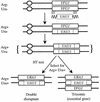Molecular genetic and genomic approaches to the study of medically important fungi
- PMID: 12704098
- PMCID: PMC153231
- DOI: 10.1128/IAI.71.5.2299-2309.2003
Molecular genetic and genomic approaches to the study of medically important fungi
Figures

Similar articles
-
Approaches to functional genomics in filamentous fungi.Cell Res. 2006 Jan;16(1):31-44. doi: 10.1038/sj.cr.7310006. Cell Res. 2006. PMID: 16467874 Review.
-
Moving toward a systems biology approach to the study of fungal pathogenesis in the rice blast fungus Magnaporthe grisea.Adv Appl Microbiol. 2005;57:177-215. doi: 10.1016/S0065-2164(05)57006-0. Adv Appl Microbiol. 2005. PMID: 16002013 Review. No abstract available.
-
Functional genomics. Pathogen researchers get help from TIGR.Science. 2001 Dec 7;294(5549):2069-70. doi: 10.1126/science.294.5549.2069a. Science. 2001. PMID: 11739924 No abstract available.
-
New genetic approaches to industrially important fungi.Biotechnol Bioeng. 1980;22 Suppl 1:49-61. Biotechnol Bioeng. 1980. PMID: 6252981 Review. No abstract available.
-
New (and used) approaches to the study of fungal pathogenicity.Annu Rev Phytopathol. 2001;39:337-65. doi: 10.1146/annurev.phyto.39.1.337. Annu Rev Phytopathol. 2001. PMID: 11701869 Review.
Cited by
-
Molecular genetic techniques for gene manipulation in Candida albicans.Virulence. 2014 May 15;5(4):507-20. doi: 10.4161/viru.28893. Epub 2014 Apr 23. Virulence. 2014. PMID: 24759671 Free PMC article. Review.
-
Identification of the major molecular types of Cryptococcus neoformans and C. gattii by Hyperbranched rolling circle amplification.PLoS One. 2014 Apr 15;9(4):e94648. doi: 10.1371/journal.pone.0094648. eCollection 2014. PLoS One. 2014. PMID: 24736745 Free PMC article.
-
In situ expression of (R)-carbonyl reductase rebalancing an asymmetric pathway improves stereoconversion efficiency of racemic mixture to (S)-phenyl-1,2-ethanediol in Candida parapsilosis CCTCC M203011.Microb Cell Fact. 2016 Aug 17;15(1):143. doi: 10.1186/s12934-016-0539-y. Microb Cell Fact. 2016. PMID: 27534936 Free PMC article.
-
The RIM101 signal transduction pathway regulates Candida albicans virulence during experimental keratomycosis.Invest Ophthalmol Vis Sci. 2010 Sep;51(9):4668-76. doi: 10.1167/iovs.09-4726. Epub 2010 Apr 7. Invest Ophthalmol Vis Sci. 2010. PMID: 20375342 Free PMC article.
-
The Candida albicans stress response gene Stomatin-Like Protein 3 is implicated in ROS-induced apoptotic-like death of yeast phase cells.PLoS One. 2018 Feb 1;13(2):e0192250. doi: 10.1371/journal.pone.0192250. eCollection 2018. PLoS One. 2018. PMID: 29389961 Free PMC article.
References
-
- Abuodeh, R. O., M. J. Orbach, M. A. Mandel, A. Das, and J. N. Galgiani. 2000. Genetic transformation of Coccidioides immitis facilitated by Agrobacterium tumefaciens. J. Infect. Dis. 181:2106-2110. - PubMed
-
- Aleksenko, A., and A. J. Clutterbuck. 1996. The plasmid replicator AMA1 in Aspergillus nidulans is an inverted duplication of a low-copy-number dispersed genomic repeat. Mol. Microbiol. 19:565-574. - PubMed
-
- Backen, A. C., I. D. Broadbent, R. W. Fetherston, J. D. Rosamond, N. F. Schnell, and M. J. Stark. 2000. Evaluation of the CaMAL2 promoter for regulated expression of genes in Candida albicans. Yeast 16:1121-1129. - PubMed
-
- Bain, J. M., C. Stubberfield, and N. A. Gow. 2001. Ura-status-dependent adhesion of Candida albicans mutants. FEMS Microbiol. Lett. 204:323-328. - PubMed
Publication types
MeSH terms
Grants and funding
LinkOut - more resources
Full Text Sources
Medical

